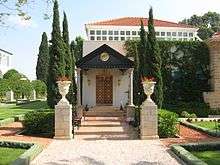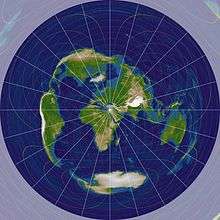Qiblih

| Part of a series on |
| Bahá'í Faith |
|---|
 |
| Central figures |
| Key scripture |
| Institutions |
| History |
| People |
| Holy sites |
|
| Other topics |
|

In the Bahá'í Faith the Qiblih (Arabic: قبلة, "direction") is the location that Bahá'ís should face when saying their daily obligatory prayers, and is fixed at the Shrine of Bahá'u'lláh, near Acre, in present-day Israel; approximately at 32°56′37″N 35°5′30.5″E / 32.94361°N 35.091806°E.
In Bábism the Qiblih was originally identified by the Báb with "the One Whom God will make manifest", a messianic figure predicted by the Báb. Bahá'u'lláh, the Prophet-founder of the Bahá'í Faith claimed to be the figure predicted by the Báb. In the Kitáb-i-Aqdas, Bahá'u'lláh confirms the Báb's ordinance and further ordains his final resting-place as the Qiblih for his followers.[1] `Abdu'l-Bahá describes that spot as the "luminous Shrine", "the place around which circumambulate the Concourse on High". The concept exists in other religions. Jews face Jerusalem, more specifically the site of the former Temple of Jerusalem. Muslims face the Kaaba in Mecca, which they also call the Qibla (another transliteration of Qiblih).
Bahá'ís do not worship the Shrine of Bahá'u'lláh or its contents, the Qiblih is simply a focal point for the obligatory prayers. When praying obligatory prayers the members of the Bahá'í Faith face in the direction of the Qiblih. It is a fixed requirement for the recitation of an obligatory prayer, but for other prayers and devotions one may follow what is written in the Qur'an: "Whichever way ye turn, there is the face of God."[2]
Burial of the dead
"The dead should be buried with their face turned towards the Qiblih. This also is in accordance with what is practiced in Islam. There is also a congregational prayer to be recited. Besides this there is no other ceremony to be performed" (From a letter written on behalf of Shoghi Effendi to an individual believer, July 6, 1935).
See also
- Qibla, the Islamic equivalent of the Qiblih
- Ad orientem, the Christian practice of facing east in prayer, also informs orientation of many church building
- Mizrah, the Jewish practice of praying facing the Temple Mount in Jerusalem
Citations
- ↑ Bahá'u'lláh 1873, p. 12, 168-169.
- ↑ Bahá'u'lláh 1873, p. 111.
References
- Bahá'u'lláh (1873). The Kitáb-i-Aqdas: The Most Holy Book. Wilmette, Illinois, USA: Bahá'í Publishing Trust. ISBN 0-85398-999-0.
- Smith, Peter (1999). A Concise Encyclopedia of the Bahá'í Faith. Oxford, UK: Oneworld Publications. ISBN 1-85168-184-1.